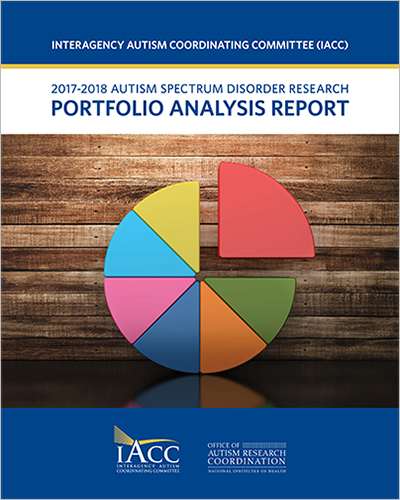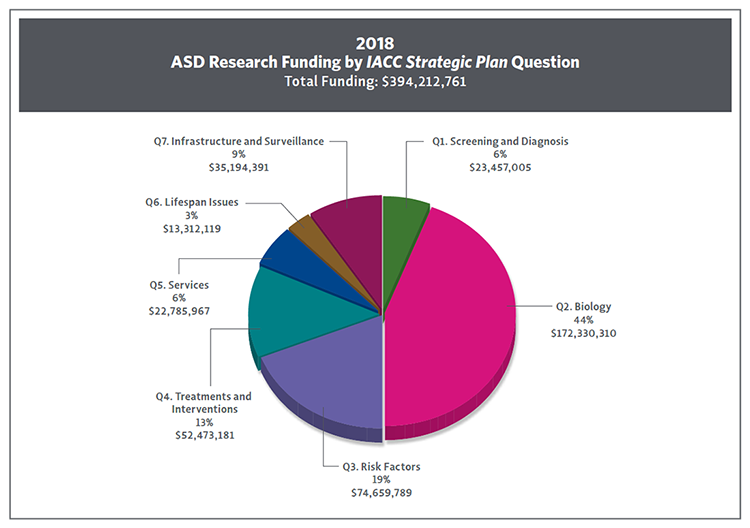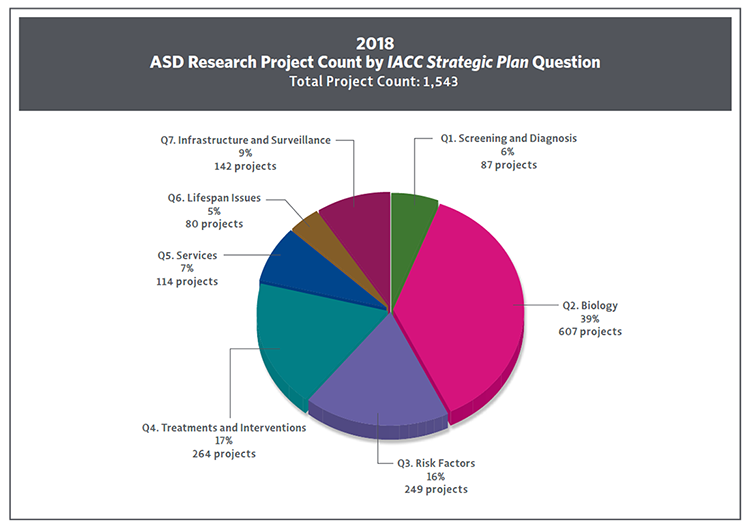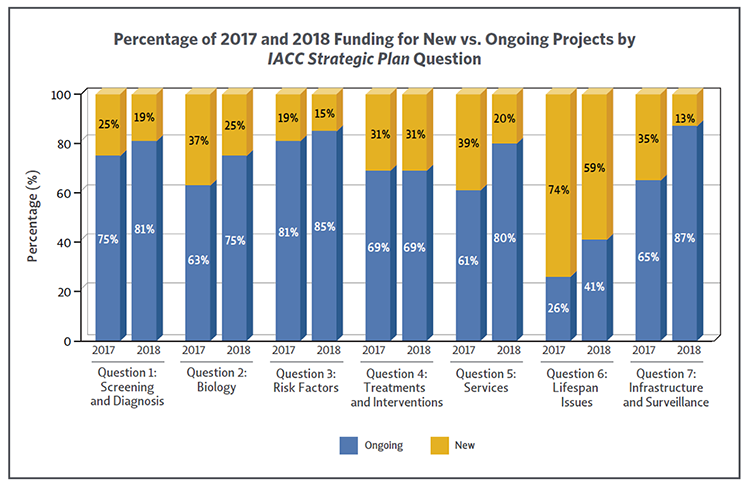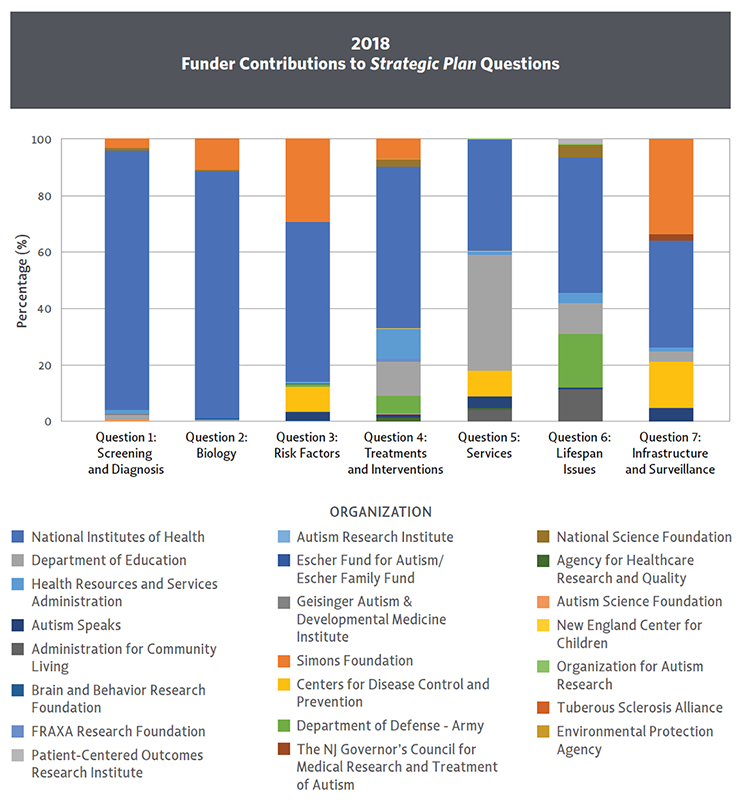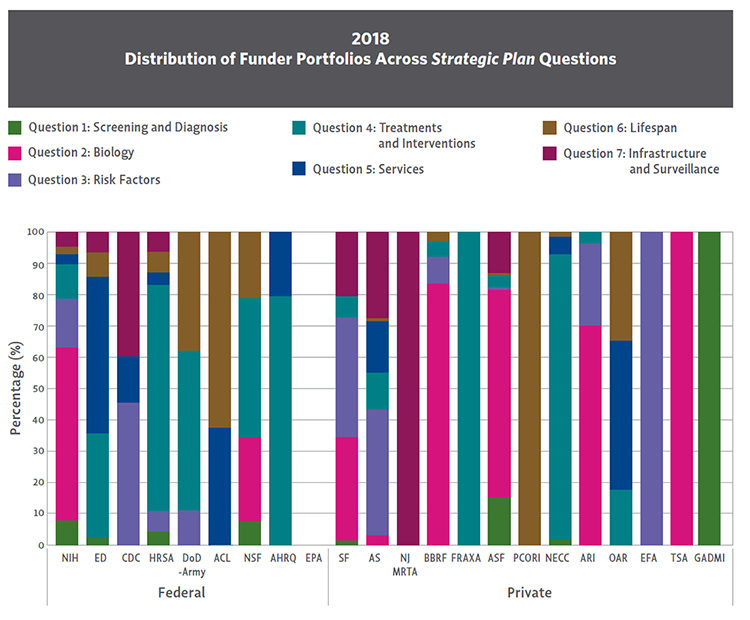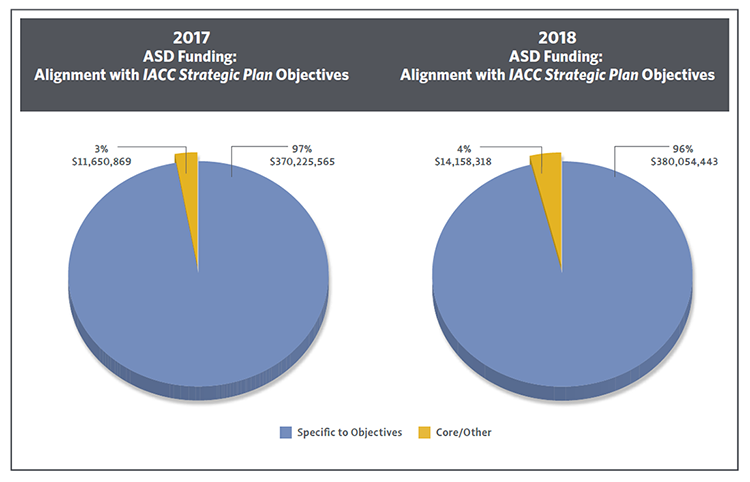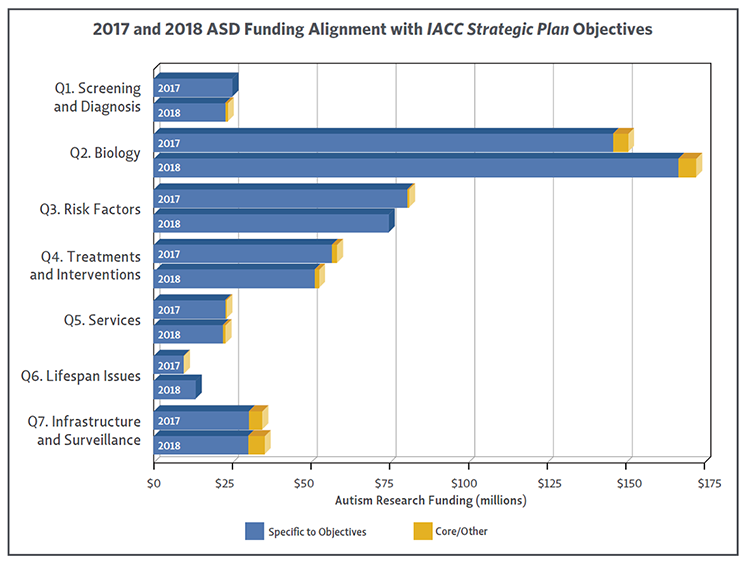Portfolio Analysis Report
IACC Autism Spectrum Disorder Research
2017-2018
ASD Research Areas and Funding in 2017-2018
What areas of ASD research were funded in 2017 and 2018?
To better understand what areas of research were funded in 2017 and 2018, projects were aligned with the Questions in the 2016-2017 IACC Strategic Plan. Figures 10 and 11 illustrate the breakdown of the research funding per each of the Strategic Plan’s seven Questions, which are related to Screening and Diagnosis (Q1), Biology (Q2), Risk Factors (Q3), Treatments and Interventions (Q4), Services (Q5), Lifespan Issues (Q6), and Infrastructure and Surveillance (Q7). Identifying how current research investments correspond to the Strategic Plan provides an understanding of how funders have directed investments across each of the priority areas identified by the IACC, as well as an indication of which areas are well-supported versus those that may need additional attention or development.
ASD research funding in 2017 and 2018 supported projects relevant to all seven Questions in the IACC Strategic Plan for ASD Research. As in previous years, the largest portion of funding addressed the underlying Biology of ASD (Question 2). This was followed by Question 3 (Risk Factors), research aimed at identifying potential causes and risk factors for ASD. Research into Treatments and Interventions for ASD (Question 4), including behavioral therapies, pharmacological treatments, and technology-based interventions, followed. Investment in research Infrastructure and Surveillance (Question 7) received nearly a tenth of funding in both years. Research focused on improving tools for Screening and Diagnosis (Question 1) as well as Services (Question 5) followed in funding levels. Lifespan Issues (Question 6) remained the smallest area of funding each year. In 2017, the percentages of total funding were as follows: Question 1, 7%; Question 2, 39%; Question 3, 21%; Question 4, 15%; Question 5, 6%; Question 6, 2%; Question 7, 9% (Figure 10). In 2018, the percentages of total funding were as follows: Question 1, 6%; Question 2, 44%; Question 3, 19%; Question 4, 13%; Question 5, 6%; Question 6, 3%; Question 7, 9% (Figure 11). Overall, from 2017 to 2018, funding increased for projects focused on Biology (Question 2), Lifespan Issues (Question 6), and Infrastructure and Surveillance (Question 7). Funding for research on Services (Question 5) remained relatively flat, and funding was slightly reduced across the remaining research areas. Subsequent sections in this report provide analyses of changes in funding over time (2008-2018) for each Question area.
Figure 10. 2017 ASD research funding by IACC Strategic Plan Question. Topic areas are defined by each Question in the IACC Strategic Plan. The seven Questions of the Strategic Plan are represented in the clockwise direction, beginning with Screening and Diagnosis (Question 1) and ending with Infrastructure and Surveillance (Question 7).
Figure 11. 2018 ASD research funding by IACC Strategic Plan Question.
When the number of projects that align with each Question is considered, as opposed to the total funding for these projects, the distribution is slightly different due to differences in the relative sizes of projects falling under each of the seven Question topics. In 2017, the percentages of total projects were as follows: Question 1, 6%; Question 2, 38%; Question 3, 17%; Question 4, 18%; Question 5, 8%; Question 6, 4%; Question 7, 9% (Figure 12). In 2018, the percentages of total projects were as follows: Question 1, 6%; Question 2, 39%; Question 3, 16%; Question 4, 17%; Question 5, 7%; Question 6, 5%; Question 7, 9% (Figure 13). The proportion of projects remained relatively constant from one year to the next.
Figure 12. 2017 ASD research project counts by IACC Strategic Plan Question.
Figure 13. 2018 ASD research project counts by IACC Strategic Plan Question.
How many new research projects were added in 2017 and 2018 compared to ongoing research?
Each project included in the Portfolio Analysis is classified as either “Ongoing” or “New.” Ongoing projects were active in a previous year, and new projects became active and received funding for the first time in the specified year of analysis. In 2017, 68% of overall ASD research funding went to ongoing projects while 32% went to new projects. In 2018, 77% of total ASD funding was assigned to ongoing projects while 23% were labeled new projects. Since most research projects are funded over multiple years, a larger number of ongoing projects compared to new projects is expected. In comparison to other Question areas, research related to Lifespan Issues (Question 6) had higher proportions of funding devoted to new projects (74% in 2017 and 59% in 2018) (Figure 14). The IACC has emphasized the need to expand research in this area, which was highlighted in the 2016-2017 IACC Strategic Plan’s budget recommendation. While Question 6 consistently has been the least funded research area over the years, a burst in newly-funded projects in this research area is promising for the field. In contrast, funding for Screening and Diagnosis (Question 1) and Risk Factors (Question 3) had the highest proportions of funding going to ongoing projects when compared to other Questions. The remaining research areas had similar proportions of funding devoted to ongoing projects.
Figure 14. The percentages of 2017 and 2018 ASD research funding directed to ongoing versus new projects varies between Strategic Plan Questions.
What types of research are funded by the different agencies and organizations?
The federal and private funders included in this Portfolio Analysis Report fund a wide range of autism-related research projects. As shown in Figure 15, federal and private funders contributed to funding for each of the Question areas in the IACC Strategic Plan for ASD in 2018. However, the proportions of federal and private funding vary by Question area, suggesting that some areas align more closely with federal or private mission areas, priorities, and/or capabilities. All Question areas received more federal funding than private funding. The research areas that received the largest amount of private funding were projects investigating the Biology of ASD (Question 2), genetic and environmental Risk Factors of ASD (Question 3), and Infrastructure and Surveillance (Question 7). Although 2017 data is not presented, there were similar federal and private funding patterns for 2017 projects.
Figure 15. Federal and private funding was provided for each Strategic Plan Question area in 2018, although the proportion of federal versus private funding varied between Question areas.
Figure 16 shows the agencies and organizations that funded projects in 2018 in each of the seven Question areas of the IACC Strategic Plan. Figure 17 illustrates the breadth of the mission areas of the funding agencies and organizations included in the IACC Portfolio Analysis Report. These two figures demonstrate that while some agencies and organizations have broad portfolios that cover many different research areas described in the IACC Strategic Plan, others focus their efforts on a narrower range of research topics.
Figure 16. The proportion of each federal agency and private organizations’ funding in the portfolio analysis organized by IACC Strategic Plan Question for 2018.
Figure 17. The portfolio of each federal agency and private organizations’ ASD projects by Strategic Plan Question for 2018. Please note that this figure is based on funding amounts from 2018. Thus, while funders may support additional areas of research, this may not be reflected in this particular year.
How did the research projects funded in 2017 and 2018 align with the Objectives in the IACC Strategic Plan?
The 23 IACC Strategic Plan Objectives were developed by the IACC to recommend priorities for investment, and they represent areas where the Committee perceived gaps in research that required increased efforts. All autism research projects in 2017 and 2018 were matched with the best fitting Question and research Objective in the IACC Strategic Plan. In some cases, based on the project description, a given project did not fit closely with any of the Strategic Plan Objectives and could only be assigned to a Strategic Plan Question. Those projects were designated as “Core/Other” rather than assigned to a specific Objective. The Core/Other category captures projects that may be related to “core” activities that help support the autism research field, projects in well-established areas of science that do not fit within the parameters of the specific research Objectives outlined in the Strategic Plan, or that represent emerging areas of research. The Core/Other designation was developed by the IACC because the Committee felt it would help readers understand that even though activities in this category fall outside the specific research Objectives of the Strategic Plan, they represent projects that are contributing in important ways to the progress of ASD research.
Analysis of the 2017 and 2018 project information determined the proportion of projects that fit within Strategic Plan Objectives versus the proportion that did not fit within Strategic Plan Objectives (Figure 18). In 2017, 3% of the funding went to projects that were designated as Core/Other. In 2018, 4% of the funding went to projects that were designated as Core/ Other. These percentages follow closely with 2016’s proportion of projects categorized as Core/Other (4%). Figure 19 illustrates the breakdown of funding within each Strategic Plan Question that was specific to the Objectives or designated as Core/Other.
Figure 18. In 2017, 3% of funding went to projects that were not specific to a particular IACC Strategic Plan Objective and were designated as Core/Other. In 2018, 4% of projects were categorized as Core/Other.
Figure 19. In 2017 and 2018, the majority of funding for ASD projects was assigned to a specific Objective within the IACC Strategic Plan Questions. However, each Question in the Strategic Plan contained projects that were not specific to a particular Objective, designated as Core/Other. Funding for projects that fall under specific Objectives are indicated in blue, and Core/Other projects are indicated in yellow. Subcategory analysis for each Question of the Strategic Plan provides a description of the research areas addressed by all projects, including those assigned to Core/Other.
Summary of Funding Toward IACC Strategic Plan Objectives
The 23 Objectives in the Strategic Plan describe specific research priorities identified by the IACC. Each ASD project that received funding in 2017 and/or 2018 was evaluated with respect to the 23 Objectives in the 2016-2017 IACC Strategic Plan for ASD in order to determine which Strategic Plan Question and Objective it fulfilled. Analysis of the full portfolio of federally and privately funded projects yielded information about the funding progress that has been made towards the Objectives in the 2016-2017 IACC Strategic Plan. Further discussion of the funding progress towards individual Strategic Plan Objectives is found in subsequent sections of this report. Future Portfolio Analysis Reports will monitor funding trends for each Objective.
The following sections in this report give an overview of the funding progress in 2017 and 2018 on research Objectives in each Question, analysis of subcategories for each Question, and a review of the overall trend in funding over time for each Question of the Strategic Plan.


